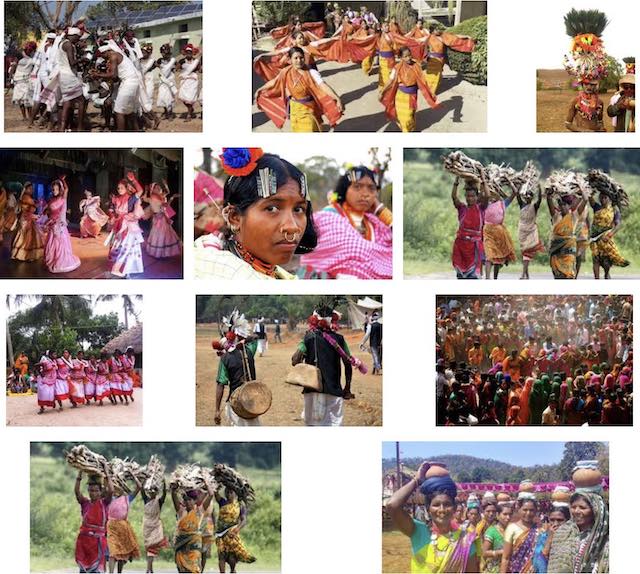Inventory of ethnobotanicals and other systematic procedures for regional conservation of medicinal and sacred plants
Author: Vijay V Wagh Affiliation: Plant Diversity, Systematics and Herbarium Division, CSIR-National Botanical Research Institute, Rana Pratap Marg, Lucknow, Uttar Pradesh, 226 001, India; Ashok K Jain Affiliation: School of Studies in Botany, Jiwaji University, Gwalior, Madhya Pradesh, 474 011, India
Publication:Environment Systems and Decisions : Formerly The Environmentalist, v35 n1 (201503): 143-156Database:SpringerLink
The plant diversity of western Madhya Pradesh is reducing at the fast rate due to anthropogenic disturbances and environmental degradation. Disturbance is a major factor responsible for the fragmentation of forest vegetation; as a result, there is a preponderance of small patches, and some of them are still preserved as sacred groves because of strong religious beliefs held by the indigenous people of Jhabua district of western Madhya Pradesh. Dungari mata sacred grove is situated near Katthiwada village in Jhabua district of western Madhya Pradesh that considered being residence of local deities. The Bhil and Bhilalaare the most dominant tribe of the study area and depend upon the forest resources for their livelihood. About 339 species, 286 genera and 82 families were found in the grove. Fabaceae (38 species), Poaceae (33 species) and Asteraceae (20 species) were dominant families, and the Ipomoea was the largest genus, with five species. About 69 tree species, 25 shrubs, 157 herbs, 40 grasses, 3 epiphytes and 45 climbers and lianas were found in the groves. Some threatened plant species are growing over here that are not found elsewhere, and they comes under various threat categories. About threatened taxa, 81 species were recorded from the grove that comes under various threat categories. The present status of the grove is of concern, as it is gradually declining under constant anthropogenic pressure. Their better management and protection are important for the conservation of plant diversity in the region and also for the benefit of indigenous tribes of the state.
Source: Inventory of ethnobotanicals and other systematic procedures for regional conservation of medicinal and sacred plants (Article, 2015) [WorldCat.org]
Address: http://www.worldcat.org/title/inventory-of-ethnobotanicals-and-other-systematic-procedures-for-regional-conservation-of-medicinal-and-sacred-plants/oclc/5790792440&referer=brief_results
Date Visited: Sun Jan 24 2016 20:54:26 GMT+0100 (CET)
The Tree of Life concept is sacred to most cultures. Its significance transcends conscious reality, touching the subconscious and beyond the undefinable. Even if the original meaning is obscured, the symbol retains an unconscious link with our primeval memory and becomes a source of strength. […]
Among the Bhil tribes in Western India, a dead ancestor’s soul is ritually appeased by the priest as he climbs the steps cut into the tree or a pole.
Once he reaches the seventh stage, the soul is released and the purified spirit rests with God. The tree is seen as a point of contact or an antenna, which reaches out to the beyond. The Tree of Life not only stands for growth, proliferation and regeneration; it is associated with the inexhaustible abundance of life, reflecting immortality and the cyclic ebb and flow of cosmic life.
In many cultures, specific trees are objects of worship; it’s taboo to cut them. The Cyprus is sacred in Iran, the Peepal in India, the Bodhi in Buddhist countries, the Baobao in West Africa, the Ficus in Ethiopia, Oak in Celtic tradition, Ash in Scandinavia, the Lime Tree in Germany and the Laurel in Greece. These trees became associated with myths and gods; hence the custom of offering libations to them. […]
Source: The tree of life – The Times of India
Address: https://timesofindia.indiatimes.com/the-tree-of-life/articleshow/6893805.cms
Date Visited: 22 May 2022
[Bold typeface added above for emphasis]
“The practice of religious rituals, ceremonies and sanctions by specific cultural groups allow such sacred landscapes to be maintained, emphasizing that humans are intrinsically part of the ecosystem. Taboos, codes and customs specific to activities and community members restrict access to most sacred groves. […] The inclusion of local people’s needs and interests in conservation planning is increasingly accepted as essential, both to promote the well-being of human populations, and to ensure that biodiversity and conservation needs are met in the long-term.” – Nazir A. Pala, Ajeet K. Neg and N.P. Todaria in “The Religious, Social and Cultural Significance of Forest Landscapes in Uttarakhand Himalaya, India” (International Journal of Conservation Science, Vol. 5, Issue 2, April-June 2014) | Sacred groves | Biodiversity and development – Himalaya >>
Up-to-date reports by Indian experts and journalists
Search tips
Combine the name of any particular state, language or region with that of any tribal (Adivasi) community.
Add keywords of special interest (music, poetry, dance just as health, sacred grove and biodiversity); learn about the rights of Scheduled Tribes such as the “Forest Rights Act” (FRA); and the United Nations “Declaration on the Rights of Indigenous Peoples”, “Universal Declaration of Human Rights”, “women’s rights”, or “children’s right to education”.
Ask a question that includes “tribal” or “Adivasi”, for instance: “Adivasi way of life better?” (or “tribal way of life worse?”)
Specify any particular issue or news item (biodiversity, bonded labour and human trafficking, climate change, ecology, economic development, ethnobotany, ethnomedicine, global warming, hunter-gatherers in a particular region or state, prevention of rural poverty, water access).
For official figures include “scheduled tribe ST” along with a union state or region: e.g. “Chhattisgarh ST community”, “Himalayan tribe”, “Scheduled tribe Tamil Nadu census”, “ST Kerala census”, “Particularly Vulnerable Tribal Group Jharkhand”, “PVTG Rajasthan”, “Adivasi ST Kerala”, “Adibasi ST West Bengal” etc.
In case the Google Custom Search window is not displayed here try the following: (1) toggle between “Reader” and regular viewing; (2) in your browser’s Security settings select “Enable JavaScript” | More tips >>
Note: hyperlinks and quotes are meant for fact-checking and information purposes only | Disclaimer >>
List of websites covered by this Google custom search engine
Academia.edu (platform for academics to share research papers) – www.academia.edu
Archive.org – https://archive.org
Centre for Science and Environment – https://www.cseindia.org
Current Conservation – https://www.currentconservation.org
Development and Cooperation (D+C) https://www.dandc.eu
Down To Earth (India) – www.downtoearth.org.in
India Environment Portal – www.indiaenvironmentportal.org.in
Harnessing Nature Magazine – https://harnessingnature.online
Mongabay-India – https://india.mongabay.com
M S Swaminathan Research Foundation – www.mssrf.org
Navdanya (protecting India’s biodiversity based food heritage) – https://navdanya.org
Third World Network (Penang, Malaysia) – https://twn.my
The Shola Trust (nature conservation in the Nilgiri region) – www.thesholatrust.org

Indian online periodicals and platforms | Images view >>
~ ~ ~
Personalize your CustomSearch by combining other search words >>
(e.g. name of a tribal community and region, a craft, or dance and puppetry)
Research the above issues with the help of Shodhganga: A reservoir of theses from universities all over India, made available under Open Access >>
Note: hyperlinks and quotes are meant for fact-checking and information purposes only | Disclaimer >>
For additional learning resources visit the website of the Centre for Science and Environment (CSE), “a public interest research and advocacy organisation based in New Delhi”:
Communication for Awareness
CSE’s publications and informational products have been its strength and they have always combined research and readability to get the message across.

CSE’s tools for awareness raising are periodicals, publications, films/short spots, briefing papers, exhibitions, posters and other products. CSE’s informational products reach people in more diverse ways such as features service, website and e-news bulletins. […]
Source: About CSE
URL: https://www.cseindia.org
Date Visited: 10 July 2022
Narmada | States along the Narmada river (from source to the Arabian Sea):
Madhya Pradesh | Maharashtra | Gujarat
Explore India’s tribal cultural heritage with the help of another interactive map >>